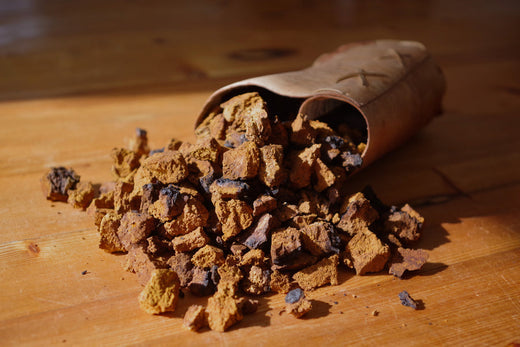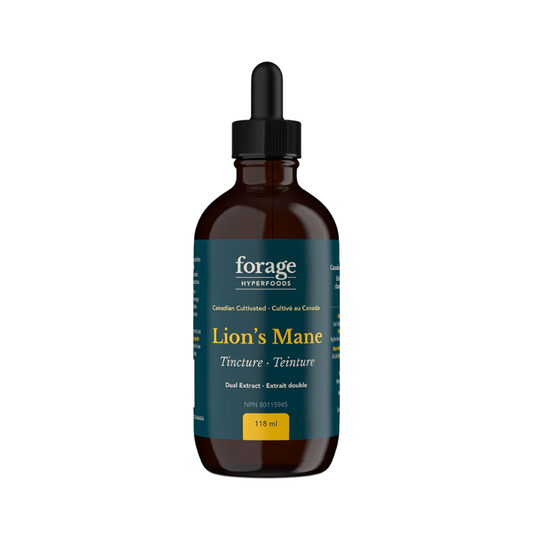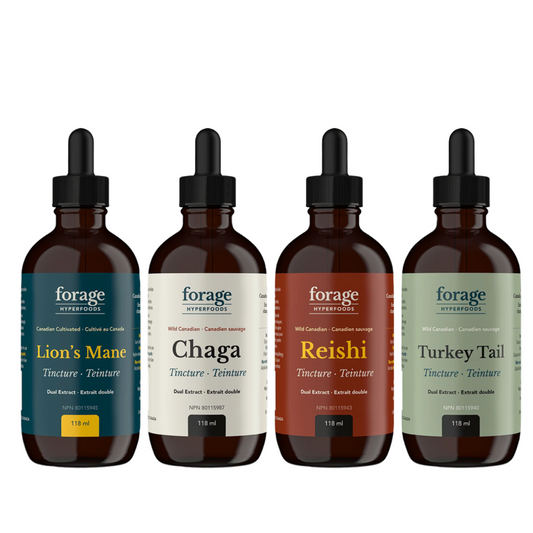
A Brief History of Chaga
Share
Chaga mushrooms have been used for medicinal purposes for centuries all over the Northern Hemisphere. Today, we’re going to dive into Chaga’s cultural history and discuss its discovery so you can get a better idea of how this medicinal mushroom made its way to the modern-day wellness world. Before we dive in, let’s quickly go over what Chaga is.
What exactly is Chaga?
Although it’s typically referred to as a mushroom, Chaga (Inonotus obliquus) is actually a sclerotia—a hardened mass of fungal mycelium. As a parasitic fungus, Chaga primarily grows on birch trees in cold climates, like those in Canada, Siberia, Scandinavia, and some parts of the United States.
Chaga doesn’t pop up from the forest floor like many more common mushrooms. Rather, Chaga appears as a charred, charcoal-like mass with a woody, orange interior. In nature, it’ll look like a black lump growing on the trunk of a birch tree.
Who discovered Chaga?
People have been using Chaga for its medicinal properties for so long that we’re not quite sure when exactly this natural remedy was first discovered. Perhaps the earliest documented use dates back 5,300 years ago when Otzi the Iceman, a well-preserved mummy discovered in 1991 in the Austrian Alps, was found to be carrying Chaga in his pouch.
Russians and Scandinavians have also known about Chaga’s health benefits for a long time. In fact, the word “Chaga” is derived from the old Russian word for “mushroom.” The word stems from Komi-Permyak, which is the language of the indigenous people living near the Ural Mountains. These native Russians, as well as the Siberian Khanty people, were supposedly the first people to use Chaga for its wide-ranging health benefits.
Chaga gains more notoriety
During the 16th to 17th century, the medicinal properties of Chaga became more formally recognized in medical texts. Chaga appears many times in the traditional folk medicine books of Russia and Northern Europe. These texts note the use of Chaga to treat cancer, gastritis, ulcers, and tuberculosis.
More recently, in the 1950s, Alexander Solzhenitsyn, a famed Russian author and Nobel laureate, became enthralled with Chaga’s many benefits while conducting research for his novel, Cancer Ward.
Chaga in modern times
Chaga is certainly no longer just a folk medicine known only to the Russians and Siberians. Since the 1950s, more than 1,600 scientific papers have researched the health benefits of Chaga mushroom.
Despite its unsightly exterior, Chaga’s wide-ranging health benefits more than make up for its lack of aesthetic beauty. Chaga is packed with antioxidants, vitamins, and minerals, making it a functional mushroom powerhouse. It’s been shown to support a strong immune system, provide anti-inflammatory benefits, support heart health, promote good digestion, and potentially play a role in cancer prevention, just to name a few things. One interesting theory is that Chaga’s many beneficial compounds may be a result of natural defense mechanisms used to withstand the cold, harsh climate it grows in.
As more information spreads about Chaga’s profound benefits, health-conscious people around the globe are adding Chaga to their daily routine. Testimonials are popping up everywhere online, while research continues to support the user's claims. Chaga is quickly becoming a widely respected superfood—and for good reason!
Find a trusted source for your Chaga
If you’re interested in trying this centuries-old functional mushroom yourself, be sure you’re getting yours from a company whose Chaga is organically grown, sustainably harvested, carefully extracted, and tested for quality and contaminants, such as heavy metals, pesticides, microbial contamination, and gluten. If a Chaga supplement lists any ingredients like “mycelium on grain” or other funky fillers, it's best to avoid it. To reap the full potential of this fungal powerhouse, seek a Chaga extract that uses wild-harvested Chaga.
The bottom line
Due to a lack of written documentation, the specifics about who discovered Chaga may never be uncovered. However, it’s clear that using Chaga for its medicinal properties dates back centuries. Thankfully, modern-day research continues to confirm the extensive benefits of this powerful fungus. If you’re curious about why so many people across the globe have used Chaga for years and years, now’s a great time to give it a try for yourself!
All referenced sources are linked in the blog.



